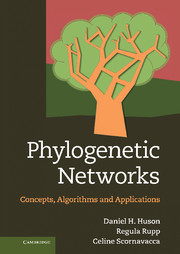Book contents
- Frontmatter
- Contents
- Preface
- Part I Introduction
- Part II Theory
- Part III Algorithms and applications
- 7 Phylogenetic networks from splits
- 8 Phylogenetic networks from clusters
- 9 Phylogenetic networks from sequences
- 10 Phylogenetic networks from distances
- 11 Phylogenetic networks from trees
- 12 Phylogenetic networks from triples or quartets
- 13 Drawing phylogenetic networks
- 14 Software
- Glossary
- References
- Index
9 - Phylogenetic networks from sequences
from Part III - Algorithms and applications
Published online by Cambridge University Press: 05 August 2011
- Frontmatter
- Contents
- Preface
- Part I Introduction
- Part II Theory
- Part III Algorithms and applications
- 7 Phylogenetic networks from splits
- 8 Phylogenetic networks from clusters
- 9 Phylogenetic networks from sequences
- 10 Phylogenetic networks from distances
- 11 Phylogenetic networks from trees
- 12 Phylogenetic networks from triples or quartets
- 13 Drawing phylogenetic networks
- 14 Software
- Glossary
- References
- Index
Summary
In this chapter we describe a number of methods that require sequences, or more precisely, a multiple sequence alignment, as input. To this end, we first introduce the useful concept of a condensed alignment and briefly discuss the relationship between binary sequences and splits. We then discuss a number of methods that can be used to compute unrooted phylogenetic networks from sequences, including the median network, quasi-median network and median-joining methods. Finally, we look at two different ways of computing rooted networks from sequences, both aimed at explaining differences in terms of mutations and recombinations.
Condensed alignments
For computational reasons, it is sometimes useful to assume that a given multiple sequence alignment M on X is condensed in the sense that no two sequences are identical and no two columns display the same pattern of states, that is, induce the same partitioning of the taxa. Additionally, we assume that a condensed alignment does not contain any constant columns (in which all sequences have the same state). We shall sometimes refer to the sequences of a condensed alignment as haplotypes.
If the original input multiple sequence alignment M0 is not condensed, then we will usually condense it in a preprocessing step as follows: first, each set of identical sequences is pooled into a single haplotype, then all constant columns are removed and, finally, every set of columns that have the same pattern is replaced by a single column i that is assigned a weight ω(i) that equals the number of columns in the represented set.
- Type
- Chapter
- Information
- Phylogenetic NetworksConcepts, Algorithms and Applications, pp. 216 - 249Publisher: Cambridge University PressPrint publication year: 2010
- 1
- Cited by



